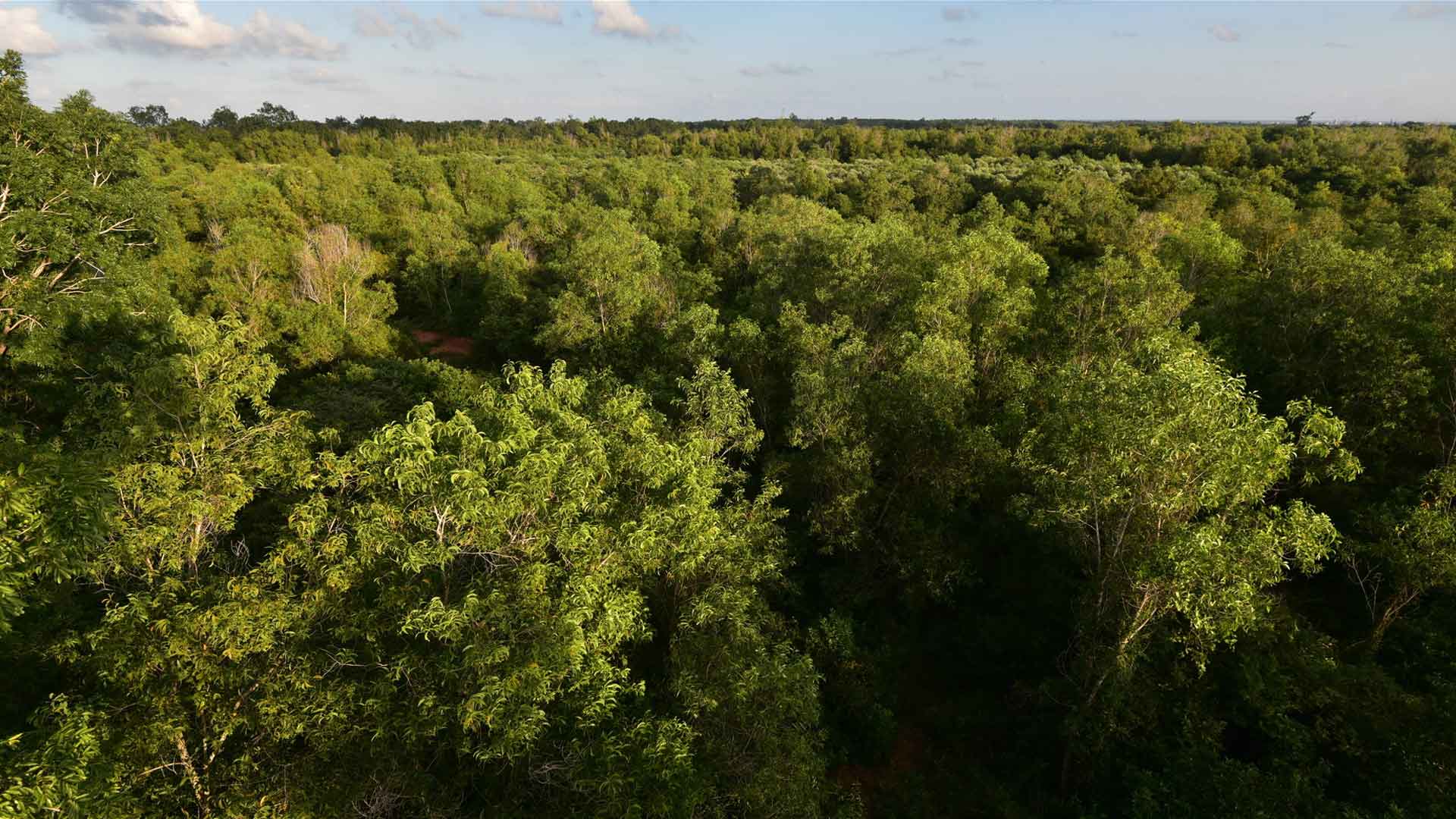
Auroville’s importance as an experiment in alternative living
9 JANUARY 2022, ASHISH KOTHARI
Bulldozers knocking down trees and threatening built-up structures at 1 am: such action can only come from a source that has no legitimacy to work during the day. Yet in early December 2021, a community in India with members from 60 countries, that has lived peacefully for over 50 years in a unique (and unfinished) experiment of multi-cultural co-existence, had to suffer precisely such a traumatic incident. But what this community, Auroville, is going through has implications that go well beyond the destruction of a few trees and structures, and well beyond even India. There are serious ramifications linked to global trends in cultural and economic authoritarianism.
Bulldozers move in
The ecological and social damage of the actions, taken in early December and proposed in the near future, are in themselves serious enough to warrant attention. Between 4th and 9th December, the Auroville Town Development Council (ATDC) backed by Auroville Foundation’s Governing Board, moved in JCBs to clear a path through a dense forest and demolish key structures of the community’s Youth Centre. Peaceful resistance by residents who urged the convening of a full Residents’ Assembly to discuss the actions was ignored; in one incident several dozen outsiders from a distant village were brought in to intimidate protesting residents. A gag order was put on Outreach Media, the community’s longstanding and respected service to reach out to the external world, with the Foundation saying only its appointed spokespersons were authorised to speak. The forest clearance work stopped only when the National Green Tribunal ordered a stay in response to a petition filed by residents.
Over 900 trees had meanwhile been felled, and some key structures of the Youth Centre demolished. An estimated 150,000 more trees and shrubs are likely to be felled for a proposed Crown Way Road that will encircle the inner core of Auroville. According to some residents and representatives of the Auroville Foundation’s Governing Board, whose members are appointed by the Central Government, this road is part of the original vision of the Mother (Mirra Alfassa, 1878–1973), who founded Auroville. The Mother was a collaborator of Sri Aurobindo, one of India’s most well-known philosophers, proponent of integral yoga, and a spiritual visionary; Auroville was her way of putting Aurobindo’s vision into practice. Most residents however dispute this ‘fact’, pointing out that the original vision, and a Master Plan made in 1999-2001, has no detailed Development Plan that dictates the precise dimensions and alignment of the Crown Way. As residents Lakshmi Venugopal and Tejaswini Mistri-Kapoor note, the Master Plan stresses an approach that is “neither traditional, nor static and rigid”. On a recent visit to Auroville, I found that residents have in fact provided alternative routes that only require minor adjustments to the official proposals, and would help save most of the trees. They pointed out to me that the Governing Board and ATDC are interpreting the Mother’s vision very rigidly, insisting on a ‘perfect circle’ with an alignment that will mean not only unnecessary levels of tree-felling but also destruction of wetlands and water courses that are crucial for the water security of Auroville and of villages downstream. At Darkali, the stewards who have helped regenerate barren land into a lush forest, showed me precious waterbodies that the ATDC alignment will destroy, whereas the alignment suggested by residents, just a few metres to the side, will help avoid this. Equally alarming is a plan to make 12 radial roads connecting the Crown Way, something not envisaged in the Master Plan, and likely to destroy even more forests and waterways.
Auroville: a dream for humanity
In 1965, The Mother put forth the idea of Auroville as “a universal town where men and women of all countries are able to live in peace and progressive harmony above all creeds, all politics and all nationalities. The purpose of Auroville is to realise human unity.” Inaugurated in 1968 with a ceremony in which people from 124 countries took part, its charter said that it “belongs to humanity as a whole … will be the place of an unending education … the bridge between the past and the future … a site for material and spiritual researches for a living embodiment of an actual human unity”. The Indian government not only enabled it by providing land and other support, but also took the idea to UNESCO in 1966, which recognised it as a project of importance for the future of humanity. Today, its residents are from nearly 60 countries, a little less than half of them Indian.
Over the last five decades, Auroville has also been the hub of lots of exciting experimentation in sustainable farming, alternative architecture and construction, watershed management and water harvesting, renewable energy, community healthcare, craft and cultural regeneration, alternative learning and education, gift economy and localised exchange, waste management, and a range of less ‘tangible’ socio-cultural dimensions of life. As described in detail in ‘Auroville: Smart City of Another Kind’, a recent publication put together by residents Claude Arpi, Alain Bernard and Christine Devin, Auroville’s initiatives range across a wide spectrum of economic, political, socio-cultural and ecological issues.
Auroville is home to one of the most incredible stories of ecological restoration in India. When it was initiated, the entire land had been degraded down to barren rock (having suffered deforestation by the Portuguese and French colonialists to establish Pondicherry). From that stage, it now boasts of over 1300 acres of lush forest, including the revival of the seriously threatened Tropical Dry Evergreen Forest and several dozen endangered species of plants and animals. Any development plan for the ‘City of Dawn’ that the Mother dreamed of, which does not respect this ecological phenomenon as also the fragile water balance of the area, must surely be seen as a violation of all that she and Sri Aurobindo stood for?
With regard to its location within a rural landscape, allegations of Auroville being a bubble in the midst of poverty, with traces of racism and casteism especially in its early years, have some basis. But several initiatives over the last few decades are trying to make it more relevant to surrounding villages and beyond, and break through conventional barriers. These include the Auroville Village Action Group (AVAG) working with several thousand women to enable enhanced livelihoods and gender empowerment; the Sustainable Livelihoods Institute doing outreach with panchayats and other rural groups in several states; Mohanam, helping to document and revive cultural traditions and crafts; the sustainable menstruation kit Eco Femme, initiated in Auroville, now nationally known; a number of schools and healthcare centres in villages; and others, also detailed in the above-mentioned book.
Many of Auroville’s residents are the first to admit that there is a long way to go on all these aspects, and a very long way to becoming a town in which humanity has achieved higher consciousness, harmony and peace. But what is happening now is likely to undermine any possibility of Auroville even moving towards such a goal.
What is the Indian government’s agenda?
What is at stake is much more than Auroville’s ecological and material future. Behind the actions of the Auroville Foundation’s Governing Board, is the heavy hand of the central government. There are several aspects of serious concern in this.
First, Auroville has been able to continue its experiment of multi-national, inter-cultural living for the last 50+ years because of an interesting collaboration between its residents and the government. This approach is built into the Auroville Foundation Act of 1988, which established Auroville as a legal entity. The Act mandates three bodies to work closely with each other: the Residents’ Assembly (currently consisting of about 2500 members), the Governing Board with independent citizens and government appointees, and an International Advisory Council of 5 eminent people. The Secretary to the Foundation is appointed by the central government. The Act’s wording suggests a vision of a fine-tuned balance amongst these bodies, with none having over-riding power over the others.
For the last three decades, this balance appears to have been maintained. Several residents mentioned that they are grateful to the government for supporting it in financial and other ways; some even told me that only India could have enabled such a trans-national experiment! But the balance has been shattered with the recent actions, in which the Foundation Secretary Jayanti Ravi, a Gujarat cadre IAS official, is reported to have a strong hand. The lack of consultation with the Residents’ Assembly in pushing ahead the clearing of ‘right of way’ for the Crown road, points to a disregard for both the Act’s spirit and for democratic principles. Is this part of the increasingly authoritarian tendencies of the party in power in Delhi? PM Modi in his address at the 50th anniversary cited the Auroville Charter’s first principle – “Auroville belongs to humanity as a whole” – yet a few people are acting as if it belongs to them, not even to all Aurovilleans, let alone all humanity. And could it also have something to do with the fact that so far, BJP has not been able to gain any significant foothold in the south Indian state of Tamil Nadu, and it aims for Auroville to be the thin end of a wedge?
Secondly, there seems to be a hurry to put into place not only the Crown Way, but a series of infrastructural projects aimed at making Auroville a city able to accommodate a population to 50,000 (its current population is about 3500). This figure comes from a statement of the Mother: “naturally, when we are fifty thousand, it will be difficult to meet the needs, but for the moment we’ll only be a few thousand at the most.” This seems to have become a justification for a massive intervention in the area, with many builders likely salivating at the possibilities of fat contracts, and ignoring another statement of the Mother made in October 1972: “In Auroville I do not want many men. I want some people, but true people. If you want many people, I can give you a hundred thousand in a moment from South Africa”.
Additionally, this could open up the area for significantly higher tourist traffic, including the kind of spiritual tourism that the central government is promoting in a big way through projects like the Chardham roads in Uttarakhand, which are massive highways through ecologically sensitive Himalayan regions. While profit-makers will undoubtedly benefit, the negative ecological and social impacts are not hard to predict, given experience from several other parts of India that are currently bearing the brunt of unregulated mass tourism. So far, no environmental audit or impact assessment has been carried out of the proposed plans; in a statement on the recent happenings, Auroville’s International Advisory Council has asked for this.
Third, and connected with both the above, there seems to be an insidious right-wing religious, Hindutva agenda. When Prime Minister Modi went for the 50th anniversary celebrations of Auroville, he spoke eloquently about Sri Aurobindo’s importance for India and humanity. He has now set up a 53-member committee to plan celebrations around Aurobindo’s 150th birth anniversary in 2022; indeed the rushed imposition of the Crown Way and other proposals for Auroville may well be connected to this. Could this be part of the ruling party BJP’s attempt to co-opt many of India’s major figures, including Gandhi and Ambedkar? Having not quite succeeded with these two given their championing of sections of India that Hindutva forces are not comfortable with (Muslims, Dalits), could it be an attempt to use Aurobindo for their hegemonic religious agenda?
Some residents I spoke to felt that PM Modi’s initiative on Sri Aurobindo may be beneficial, given that Aurobindo’s philosophy and approach are well beyond narrow political considerations. But that may be naïve; through history, authoritarian governments and leaders have successfully appropriated charismatic figures and even revolutionary worldviews for their own ends. I may be wrong about the real intentions of the party in power, and I’d be happy if I am, but it would not hurt for followers of Aurobindo to keep a close watch on the nature and outcome of the anniversary events.
The current government’s toxic mix of right-wing cultural imposition and capitalist commercialisation is already playing out in various forms in what New Delhi considers the ‘frontiers’ – Ladakh, Kashmir, north-east India, Andaman and Nicobar Islands, Lakshadweep Islands. Auroville may well be the next target.
Pathways to the City of Dawn
Whatever the intentions of the central government, Auroville faces a huge challenge. The recent incidents have sharply exposed its own internal divisions and created a polarisation that will take all the mediation skills of its residents to resolve. Vested interests are using long-standing faultlines (some real, some perceived, some exaggerated): Indian and non-Indian, Tamil and non-Tamil, residents and surrounding rural communities, ‘ordinary’ residents and those in positions of authority. Several residents I spoke to said that the relative comfort and harmonious way of life in Auroville had created a bubble, disabling its readiness to face challenges from outside (or within). Some said they’d lost several years of opportunity to create a strong, dialogue-based Residents’ Assembly that could stand unified in the face of such challenges. Of serious concern is the fact that several members of the Working Committee, appointed by the Residents’ Assembly for liaison with the Foundation officials and the Governing Board, sided with the heavy-handed actions of early December. Others readily admitted that many lingering issues of racism, casteism, and class inequities have to be resolved. All agreed that the current crisis was a kick in the backside, an opportunity to wake up and get its act together, to get anywhere near The Mother’s vision of “a place where men can live away from all national rivalries, social conventions, self-contradictory moralities and contending religions; a place where human beings, freed from all slavery to the past, can devote themselves wholly to the discovery and practice of the Divine Consciousness that is seeking to manifest.”
Such an opportunity is provided by a new initiative at ‘dreamweaving’, to develop a detailed plan for Auroville through extensive consultations and based on the best available studies and expertise. A necessary part of such an exercise would be how to deal with the above faultlines, integrate neighbouring villages like Edayanchavadi, Kottakarai, and Alankuppam as part of the design, and ensure that Auroville does not become an exclusive, exclusionary space only the rich can live in. It is to be hoped that the involvement of the architect Balkrishna Doshi’s firm Vastu Shilpa Consultants, whom the Auroville Foundation is considering contracting, would contribute to such an approach. Doshi is globally known for integrating vernacular, environmentally sensitive techniques into his work, for which he has received the world’s biggest architecture awards. Elements of alternative visions for Auroville’s development have been worked on by residents, including architect Suhasini Ayer, who recently won the Green Solutions Award at the Climate COP26 for her ‘Humanscapes Habitat’ approach to sustainable urban living. But as many participants said at a meeting to discuss the Dreamweaving approach on 27th December, attended by several hundred residents: for any planning to be meaningful, the JCBs waiting to clear further forests in Auroville need to be moved away. Democracy and sound decision-making cannot work under the shadow of bulldozers.
Hopefully, this initiative can also ask basic questions about how much and what forms of mobility are needed in Auroville. If it aims to be truly evolutionary, could it move away from private cars, for instance, and substantially to public transport, cycling and walking? This in turn is linked to questions such as what forms of economy could lead to sustainability and self-reliance; could it move much more towards localised, non-monetary and local currency based exchange systems? Some long-term residents like Olivier Barot and several younger residents, including Indians who have more recently joined the Auroville community, are exploring such systems. And then, how can governance be truly centred around a democratic Residents’ Assembly? If it truly wants to be ‘the city the Earth needs‘, a vision of well-being that is holistic, sustainable, and equitable is needed. Many elements of this already exist in practical experiments and in proposals, both within and outside Auroville, but have to be threaded together into a coherent whole.
For anyone interested in Auroville’s importance as an experiment in alternative living, such a process should be of great interest. This was emphasised in a statement of support to Auroville by Vikalp Sangam, a national platform of organisations and movements searching for alternatives to today’s destructive mode of development and the underlying structures of capitalism, state-domination, patriarchy, casteism, and human-centredness. It said that Auroville continues to have a crucial role “in the research and design of systems of food production, ecological restoration, natural healthcare, education, architecture, and watershed-sensitive town planning” and “as a site for innovation towards collective creativity and harmony.”
As one of the first residents, Frederick, told me: “Auroville needs to follow its own dharma, a trans-religious, trans-national, trans-cultural living, and as a laboratory for experiments towards a higher consciousness, and for this it needs time and space.” Indeed, if it can show how people from 60 nationalities and from myriad backgrounds and persuasions and ways of life can live together, creating an ecologically sustainable and equitable model of co-existence, it could inspire hundreds of other such initiatives around the world. This is what must be protected from the machinations of New Delhi, and from attempts to rush through rigidly imposed, non-participatory, ecologically dubious infrastructural development.


